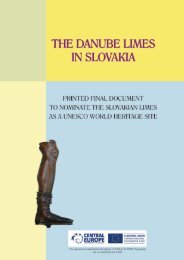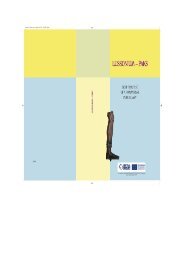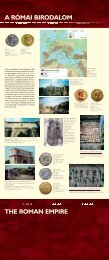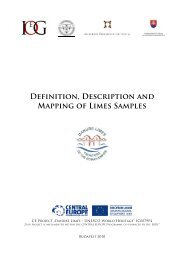the PDF version! - Danube Limes
the PDF version! - Danube Limes
the PDF version! - Danube Limes
Create successful ePaper yourself
Turn your PDF publications into a flip-book with our unique Google optimized e-Paper software.
Frontiers of <strong>the</strong> Roman Empire – Ripa Pannonica in Hungary (RPH) Nomination statement<br />
construction of <strong>the</strong> system of watch towers, <strong>the</strong> defensive modernization of <strong>the</strong> forts in response to <strong>the</strong><br />
greater barbarian threat, <strong>the</strong> construction of watch towers at closer intervals and finally <strong>the</strong> 4 th century<br />
construction of forts and fortlets to accommodate for <strong>the</strong> decrease in military forces.<br />
In relation to construction materials, <strong>the</strong> defensive systems made of earthworks can be au<strong>the</strong>ntically<br />
determined, <strong>the</strong>re are surviving marks that show evidence of wooden construction and <strong>the</strong> remains of<br />
stone structures have been excavated or are able to be excavated. The former construction techniques,<br />
numerous carvings, stone inscriptions and o<strong>the</strong>r finds that have been au<strong>the</strong>ntically preserved bear<br />
witness to <strong>the</strong> standard of architecture, <strong>the</strong> significance of <strong>the</strong> border defenses, <strong>the</strong> ethnic, religious and<br />
cultural life of <strong>the</strong> time and <strong>the</strong> intermingling and interaction of peoples and nations. These finds are<br />
also important chronological reference points for this au<strong>the</strong>nticity, through which <strong>the</strong> development of <strong>the</strong><br />
changing border defense system can be traced with precision to a decade or even a year, making it possible<br />
to corroborate <strong>the</strong>m in relation to world history.<br />
The finds support <strong>the</strong> integrity and au<strong>the</strong>nticity of <strong>the</strong> Ripa Pannonica, along with <strong>the</strong> important<br />
documentation, are publicly conserved and safeguarded in <strong>the</strong> institutions of <strong>the</strong> two hundred year old<br />
Hungarian museum system.<br />
In relation to its integrity, <strong>the</strong> entire Hungarian section of <strong>the</strong> Ripa Pannonica – toge<strong>the</strong>r with its structures<br />
– has been surveyed and inventoried, as verified through archaeological excavations, <strong>the</strong> processing of<br />
archival records and surveys, <strong>the</strong> analysis and evaluation of aerial photographs taken before <strong>the</strong> major<br />
construction and agricultural transformations and <strong>the</strong> scholarly research that extends to <strong>the</strong> examination<br />
of <strong>the</strong>se and all o<strong>the</strong>r historical data. Within this realm of integrity, a strict review of <strong>the</strong> research has<br />
separated <strong>the</strong> elements and sections that have been fully verified and documented and those that have<br />
not yet gone through this process. These latter may be placed in <strong>the</strong> category of well-founded inferences<br />
or hypo<strong>the</strong>ses. In <strong>the</strong> light of this research, it can be stated that <strong>the</strong> proposed sites represent <strong>the</strong> entirety<br />
of <strong>the</strong> Ripa Pannonica. In <strong>the</strong> proposal, every characteristic functional element of <strong>the</strong> RPH is included,<br />
and <strong>the</strong> historical development of every characteristic functional element toge<strong>the</strong>r with its system of<br />
relationships is represented in its entirety. In addition, every nominated element has been verified and<br />
au<strong>the</strong>nticated through non-destructive archaeological methods (e.g. intensive field survey, geophysical<br />
survey, aerial archaeology).<br />
The Ripa Pannonica is a site well suited to present a Roman river border defense system in an interdisciplinary<br />
manner, and through <strong>the</strong> exhibition of its archaeological remains it disseminates important historical<br />
knowledge in relation to this.<br />
Through <strong>the</strong>ir exhibition of <strong>the</strong> abundant finds from <strong>the</strong> Ripa, <strong>the</strong> museum institutions related to <strong>the</strong><br />
sites contribute to <strong>the</strong> understanding of <strong>the</strong> Ripa Pannonica, Roman civilization and culture and <strong>the</strong>ir<br />
importance as evidence from world history, and also contribute to <strong>the</strong> full analysis and comprehension of<br />
<strong>the</strong> in situ remains.<br />
53











